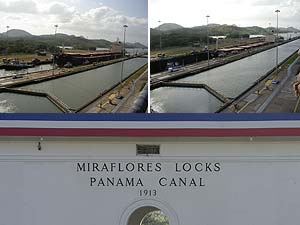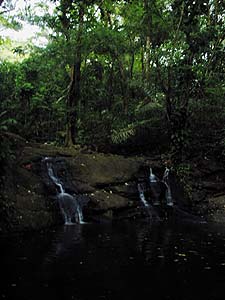 I had only one sightseeing hope for this trip: a peek of the Panama Canal. So imagine how thrilled I was to get a scheduled opportunity to see it all in action at Miraflores Lock, located just minutes from our offices. (
I had only one sightseeing hope for this trip: a peek of the Panama Canal. So imagine how thrilled I was to get a scheduled opportunity to see it all in action at Miraflores Lock, located just minutes from our offices. (
See my Panama photo album.)
Spending almost an hour watching a gigantic tanker of maximum width – leaving just a few feet of clearance on each side – being guided through the lock and dropping some 55 feet in the process doesn’t sound all that thrilling, but it’s actually quite fascinating.
The related lingo also put a grin on my face. “Panamax,” meaning a transiting ship of maximum width. A “hot ship,” the passage of which is accompanied by red flashing lights that forbid all in the vicinity from lighting up anything because its contents are highly flammable. A page-turning action novel could be conjured on the jargon alone.
Drive about 15 minutes beyond our offices and you can find yourself in the Sendera jungle, complete with snakes (a small one cleared to the side of the footpath but then lay there, unafraid and watched us) and rabid, vicious ants. (Note to self and others: ants + open shoes are a bad combination. It’s two days later and I’m still plagued by the burning welts left from their ankle-high attack.)
 In the city, you could also take a trip along ‘Causeway,’ the over sea road that connects the mainland to four islands. More than a mile long, it’s ideal for a cycle, run or walk (like the residents do), has great views of the city and tons of restaurants. (I only had time for a few pix and a delectable dulce de leche ice cream cone from Alberto’s Gelateria.)
In the city, you could also take a trip along ‘Causeway,’ the over sea road that connects the mainland to four islands. More than a mile long, it’s ideal for a cycle, run or walk (like the residents do), has great views of the city and tons of restaurants. (I only had time for a few pix and a delectable dulce de leche ice cream cone from Alberto’s Gelateria.)
But whatever you do, make Casco Viejo, a stop. The barrio, declared a UNESCO World Heritage site, is utter charm. Today, the mix still tilts strongly in favour of the original, working class residents, rather than the government upgrade projects and restored buildings under private ownership. In a few years it is likely that the entire neighbourhood will be a pristine, fully restored colonial wonder, but you will have missed the gritty originality.
That means you won’t see the small tabaquerias with their household staples, the kids playing soccer in the parks and cycling the streets, the men doing impromptu car repairs on side streets, the menagerie of domestic animals, drying laundry strung across the balconies, or the neighbours taking over the sidewalks and streets as dusk falls and converting them to one large neighbourhood living room filled with chairs and chatter.
The government is eager to realize the tourism potential of this area and is running a generous relocation programme for the current residents, as well as encouraging all comers to renovate and restore while preserving the facades. But I guess I am a sucker for community, a believer that the heart of a place is more than clean and crime-free streets, it’s people. So go now. The palatial residences (including one for the president), the upscale restaurants and the designer boutiques are few but growing.
Having more than satisfied my one tourism ambition (the canal), I also managed to satisfy the ambitions of the two hat-afficionados in my life. Yes, it’s possible to buy a real Panama hat in Panama. Bizarre statement? That’s only because the hat popularized during the canal construction that became known as the ‘Panama hat’ is in fact made in Ecuador.
One response
Amazing that a place such as Casco Viejo would have survived the building of the canal and subsequent developments. Good to see UNESCO doing its job.